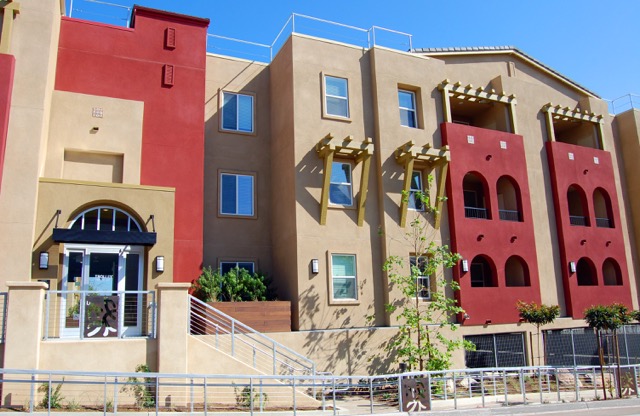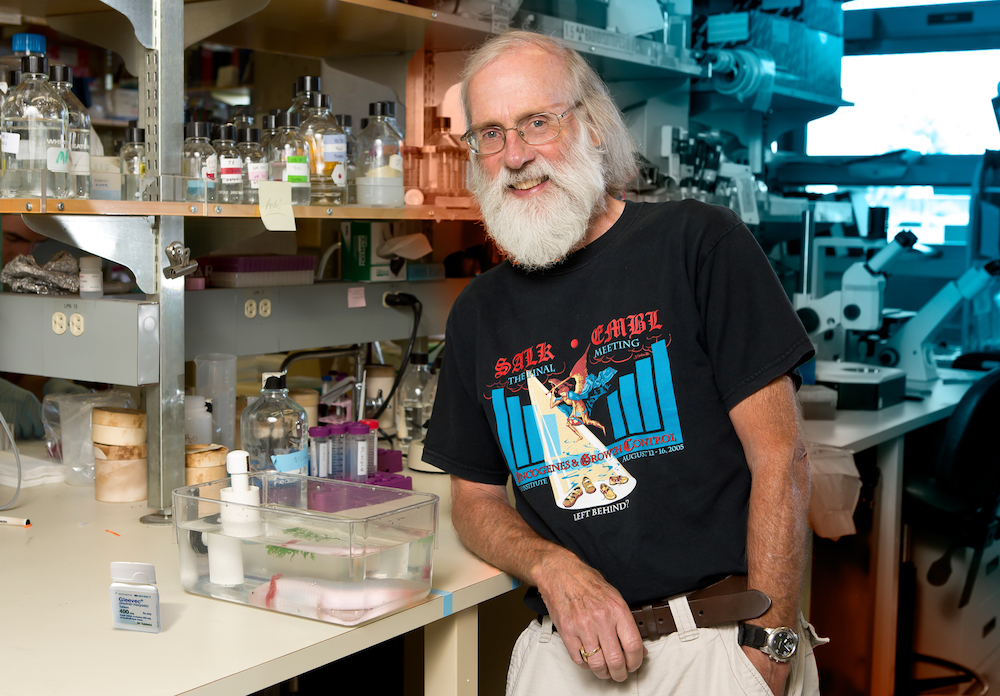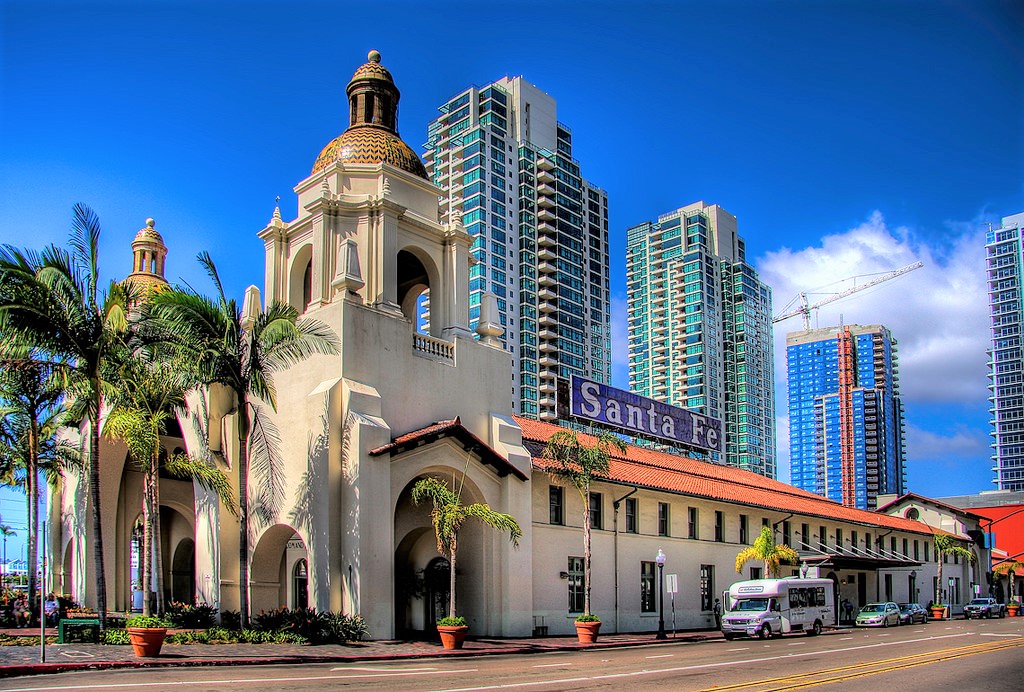Daily Business Report-Nov. 1, 2016
Trolley Park Terrace in Southeast San Diego. (Courtesy Chelsea Investment Corp.)
Chelsea Investment Corp. Puts 2 Affordable
Apartment Projects in San Diego Market

(Courtesy Chelsea Investment Corp.)
Chelsea Investment Corp. has completed two new affordable apartment communities in San Diego — the 52-unit Trolley Park Terrace in Southeast San Diego and the 28-unit Torrey Vale apartment complex on the northern perimeter of the city.
Located at 4985 Market St., Trolley Park Terrace is part of the ongoing redevelopment of 60 acres of former industrial property by the Jacobs Center for Neighborhood Innovation. Adjacent to San Diego’s second largest transit station at Euclid Avenue, Trolley Park Terrace is across the street from the Joe and Vi Jacobs Center events and microenterprise pavilion and within walking distance of resident-serving businesses at the Market Creek Plaza shopping center. The building is LEED Gold certified for energy efficiencies.
Built in partnership with the San Diego Housing Commission, Trolley Park Terrace serves families with incomes from 30 to 60 percent of the San Diego Area Median Income (AMI). With one-to three-bedroom apartments with secured belowground parking, the three-story Trolley Park Terrace features a community room, computer lab, sports court and children’s play area. Created by San Diego architect McKinley Associates, the domed Mission-style building features vibrant colors, decorative accent tiles, wood awnings, wrought-iron railing and multiple segmented arches.
Trolley Park Terrace also features after-school programs for children and on-site classes for adults and will remain affordable for 55 years.
Chelsea celebrated the grand opening of Torrey Vale Apartments last month, where 28 affordable homes offer two- and three-bedroom units, each with a private garage, and rooftop solar to power common area utilities.
Also in partnership with the San Diego Housing Commission, Chelsea developed Torrey Vale Apartments for families with incomes between 50 to 60 percent of the San Diego AMI. Located at 6525 Rancho Del Sol Way, Torrey Vale satisfies the inclusionary housing requirement for two market rate projects in the area by the master developer, Taylor Morrison.
“This closed escrow in January, so this is 10 months of construction and these families are in,” said Debbie Ruane of the San Diego Housing Commission, during a recent grand opening ceremony. “Twenty eight families are already housed in this amazing community.”
___________________________
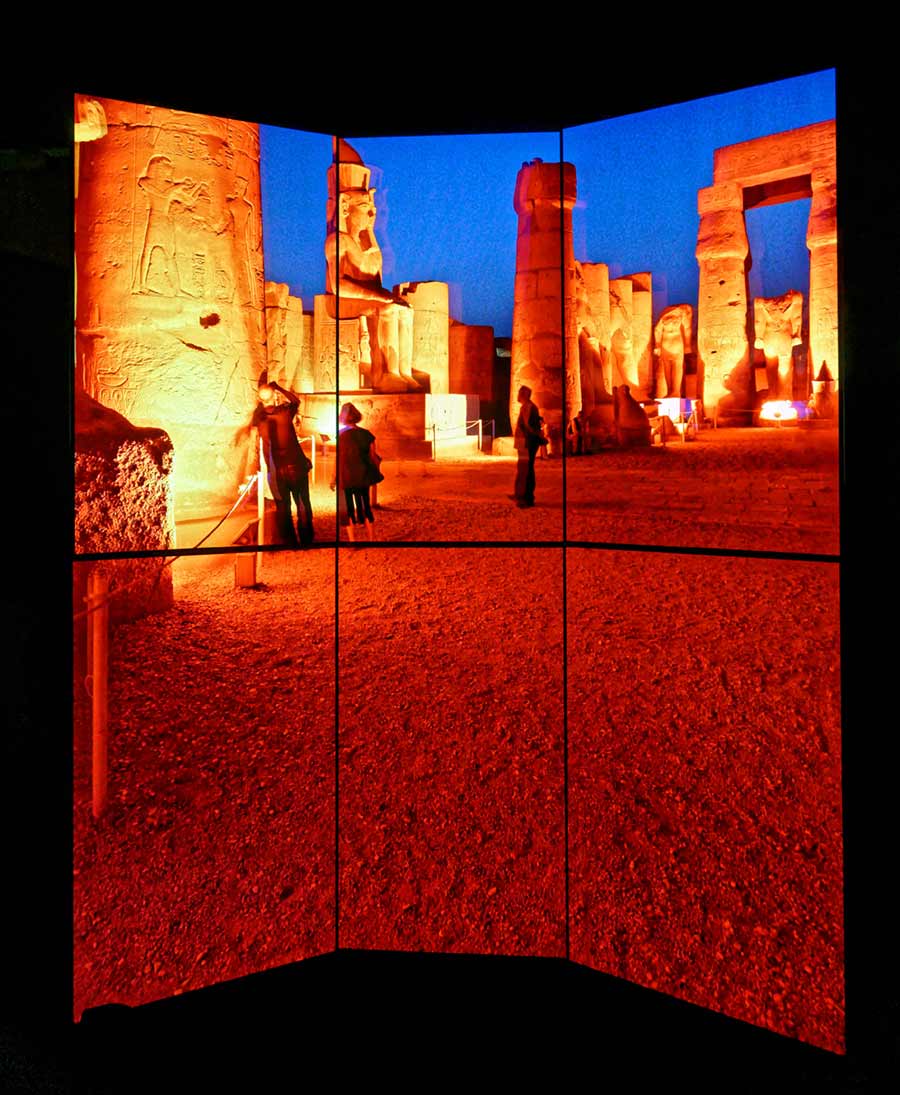
Geisel Library to Unveil First
Virtual Reality 3-D Display System
UC San Diego’s Geisel Library will unveil its first virtual-reality 3-D display system on Nov. 7 allowing researchers to analyze and visualize 3-D data from at-risk archaeological sites in Egypt, Turkey, Jordan, Israel, Greece, Morocco and Cyprus.
The unveiling will be during a public reception from 10 a.m. to noon. The life-size CAVEkiosk will be open to the campus community and the public at large.
The Geisel Library kiosk is one of four kiosks planned for University of California campuses at San Diego, Berkeley, Los Angeles, and Merced. All are partners in a UC collaboration led by UC San Diego archaeologist Thomas E. Levy, a professor in the Department of Anthropology and director of the Qualcomm Institute’s Center for Cyber-Archaeology and Sustainability.
The At-Risk Cultural Heritage and Digital Humanities project, funded by a UC President’s Research Catalyst Award, leverages a 10-100 Gigabits-per-second network — the National Science Foundation-funded Pacific Research Platform — to harness and preserve “big data” to ensure that endangered cultural heritage resources are preserved and safeguarded.
“We have just completed the first year of our Catalyst grant,” said Levy. “The installation of the 3-D CAVEkiosk in UC San Diego’s Geisel Library marks the completion of a major research goal of the project, so our team is very excited about that. In addition to catalyzing cyber-archaeology work and providing virtual reality-equipped network bandwidth with which UC scholars can collaborate, share, store and visualize at-risk cultural heritage data, members of the campus communities and visitors to the kiosks can ‘travel’ to cultural heritage sites and explore them as if they were there.”
The CAVEkiosk technology — CAVE stands for “cave automated virtual environment” — was pioneered by Tom DeFanti, senior research scientist and scientific visualization leader with the Qualcomm Institute, the UC San Diego division of Calit2.
___________________________
USD Economic Index Forecasts Increase
Of 30,000 Jobs in San Diego Next Year
The USD Burnham-Moores Center for Real Estate’s Index of Leading Economic Indicators for San Diego County was unchanged in September. Increasing and decreasing components were even at three apiece.
On the positive side were local stock prices, consumer confidence, and the outlook for the national economy. These were offset by declines in residential units authorized by building permits, initial claims for unemployment insurance, and help wanted advertising.
September’s unchanged reading leaves the USD Index roughly where it was in February. The interim has been a roller coaster, with the Index initially surging but then slumping in the early summer. It has flattened out in the last couple of months, so the outlook for the local economy is unchanged from what has been reported in recent months.
The local economy is expected to be positive at least through the first half of 2017, but the rate of growth is likely to be slower. Through the first three quarters on 2016, employment is up about 35,000 jobs compared to the same period in 2015. Employment is up in every major sector, but the strongest gains have been in health care (+6,500 jobs), leisure and hospitality (+6,300), government (+5,500, primarily in education), administrative, support, and waste services (+3,900), and construction (+2,600).
The initial forecast for 2017 is for an increase of 30,000 jobs for the year. That is a solid gain but it is unlikely to put much of a dent in the local unemployment rate.
This is the 25th anniversary edition of the Leading Economic Index Report.
Click here for a short video of Professor Gin reflecting on the latest report and the anniversary.
___________________________
65-Year-Old Hillcrest Fire
Station to Undergo Reconstruction
Fire Station No. 5 in Hillcrest has served the community for more than a half century and is now scheduled for a $9.2 million makeover, officials are reporting. Built in 1951, the station located at 3902 Ninth Ave., will undergo reconstruction and modernization to better serve the growing population in Hillcrest and surrounding neighborhoods, Mayor Kevin Faulconer’s office announced Monday
The new 10,731-square-foot, two-floor station is scheduled to include a larger apparatus bay able to house a fire engine, a fire ladder truck and a chief emergency vehicle, according to a news release from the mayor’s office. The project will more than double the size of the current station, which is too small to house modern-day ladder trucks, the release stated.
The current facility will be demolished in late November. “During construction, fire crews will be working out of a temporary facility on Third Avenue to ensure no interruption in emergency service,” the release continued.
___________________________
EPA and Regional Water Board Propose
Wastewater Discharge Permit for Point Loma Plant
The U.S. Environmental Protection Agency and the San Diego Regional Water Quality Control Board are proposing a wastewater discharge permit for the city’s Point Loma Wastewater Treatment Plant that would ensure that all federal and state water quality standards are met.
In 2014, the city and environmental organizations signed an agreement for the city to implement a potable water reuse plan. Known as Pure Water San Diego, this plan would eventually divert up to 83 million gallons of Point Loma wastewater per day from ocean discharges to an advanced water purification facility. Once built, the facility would send highly purified water to augment local drinking water reservoirs or other reuse projects.
“San Diego has made a commitment to reduce pollutant discharges through its ocean outfall,” said Alexis Strauss, EPA’s acting regional administrator for the Pacific Southwest. “Today’s proposal furthers EPA and the state’s longstanding priority of taking action to protect Southern California’s coastal waters.”
The city of San Diego must apply for a permit renewal every five years and is required to meet secondary treatment levels. EPA may grant a modification of these standards for ocean discharges if federal and state water quality standards are met.
___________________________
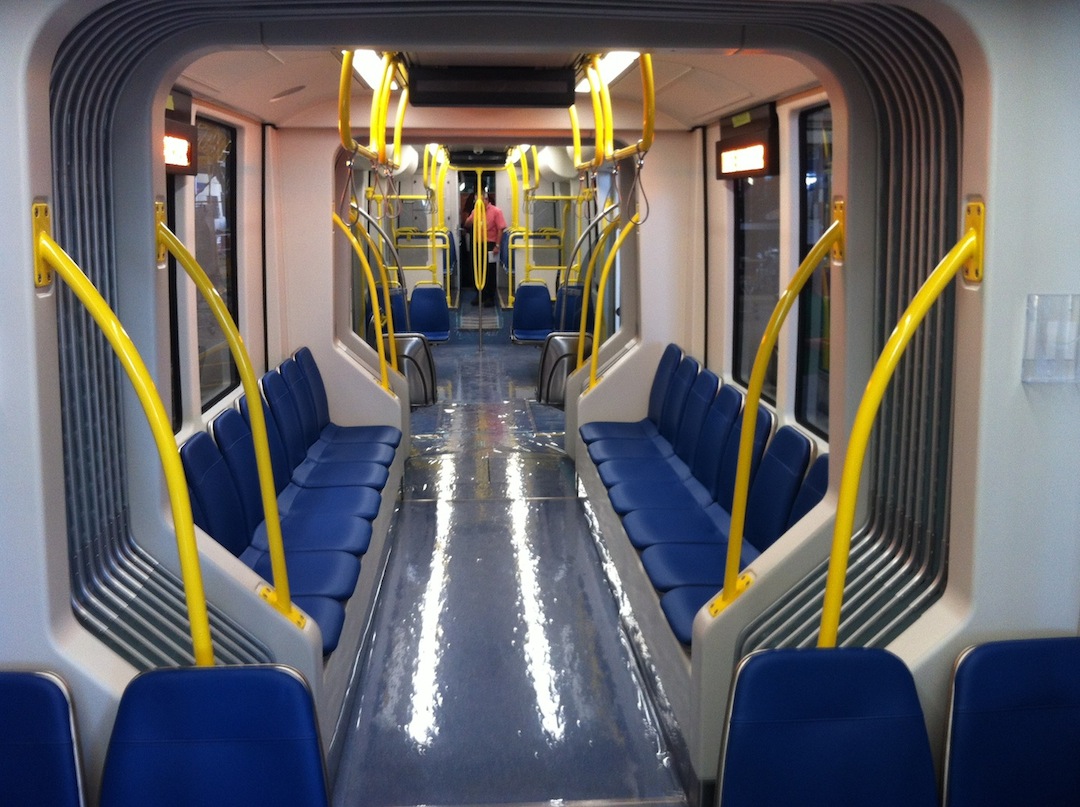
MTS Orders 45 Newly Designed
Light-Rail Vehicles from Siemens
The San Diego Metropolitan Transit System has ordered 45 newly designed S70 low-floor light rail vehicles from Siemens that feature a redesigned middle section to improve passenger flow and greater wheelchair accessibility and bicycle storage.
MTS will use 36 of the vehicles on its Mid-Coast Trolley expansion, a new service to handle future travel demand to and from University City. The other nine vehicles will be used on the UC San Diego Blue and Orange lines.
The S70s will be built at the Siemens rail manufacturing hub in Sacramento. The first vehicles are expected to arrive in late 2018.
Siemens has been providing LRVs to MTS since 1981. This order will bring the total number of vehicles supplied to MTS to 244, making MTS the largest U.S. light rail customer for Siemens. MTS recently sold or retired 71 Siemens U-2 vehicles, which were the original vehicles on the nation’s first modern light rail system. The original 15-mile segment from the International Border to Downtown San Diego has since grown to more than 53 miles of double-tracked railway that serves the entire urbanized area of San Diego.
___________________________
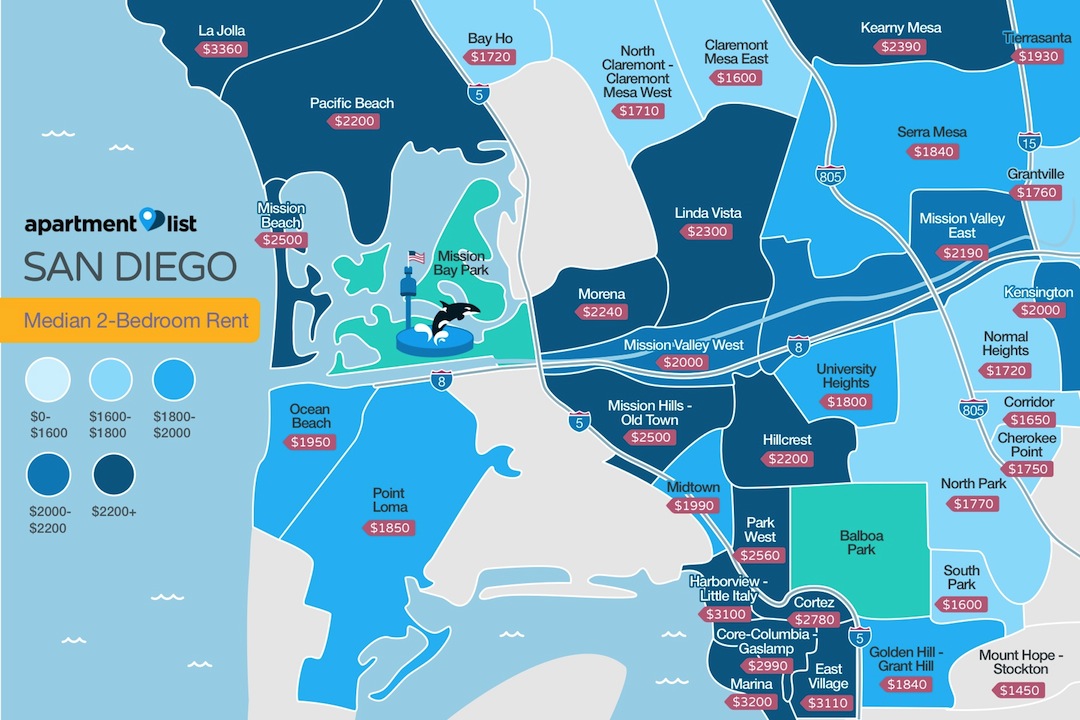
November 2016 San Diego Rent Report
Rents decreased by .02 percent over the past month
San Diego rents decreased by 0.2 percent over the past month, but prices are up 2.4 percent over last year, according to Apartment List. One-bedrooms in San Diego have a median rent of $1,500, while 2-bedrooms cost $2,020.
San Francisco: Once again, San Francisco is the most expensive city for renters in the state. A 2-bedroom there costs $4,700, and 1-beds run $3,440. Rent prices in San Francisco have decreased by 3.6 percent over the past year.
Los Angeles: With a 0.2 percent increase in rents over the past month, LA is now the second most expensive city for renters in California. Two bedrooms in LA have a median rent of $2,600, while 1-bedrooms cost $1,890.
San Jose: Having experienced a 0.2 percent decrease in rents over the last month, San Jose is now California’s third most expensive city for renters. One and two bedrooms cost $2,110 and $2,600, respectively.
Long Beach: Long Beach has the fastest-growing rents in California, having experienced a 4.3 increase increase over the past year. Two bedrooms in Long Beach rent for $2,000, and One-beds cost $1,440.
Anaheim: Anaheim has California’s 2nd fastest-growing rents, with prices 3.7 percent higher than they were last year. Median rents in Anaheim are at $1,720 for a two-bedroom and $1,400 for a one-bedroom.
Fresno: Rent prices in Fresno increased by 1.3 percent over the past year. Rents here grew by 0.4 percent over the past month and are at $870 for a two-bedroom and $750 for a one-bedroom.

